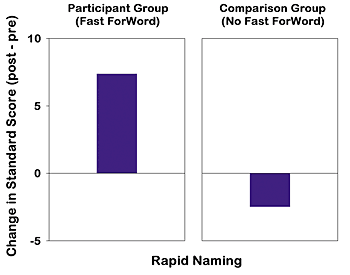Results - Dyslexia
Stanford University (USA) Brain Imaging Study
Brain imaging scans of children with dyslexia who used the Fast ForWord Language product showed normalisation of activity in critical areas of the brain used for reading. Furthermore, this group of students showed significant improvements in reading and oral language skills on a number of assessments.
Improved Fluency
Methodology
The study included children with dyslexia aged 8 to 12 years, who used the Fast ForWord Language program for eight weeks.
Before and after Fast ForWord Language participation, their brains were scanned using functional magnetic resonance imaging (fMRI) at Stanford's Lucas Center for Magnetic Resonance Spectroscopy. At both time points, their language and reading skills were measured using the Woodcock Reading Mastery Test - Revised (WRMT-R), the Clinical Evaluation of Language Fundamentals, Third Edition (CELF-3), and the Comprehensive Test of Phonological Processing (CTOPP).
A control group of children with normal reading abilities also had their brains scanned, and completed the same test battery at both time points, but they did not use the Fast ForWord Language program.
Before and after Fast ForWord Language participation, their brains were scanned using functional magnetic resonance imaging (fMRI) at Stanford's Lucas Center for Magnetic Resonance Spectroscopy. At both time points, their language and reading skills were measured using the Woodcock Reading Mastery Test - Revised (WRMT-R), the Clinical Evaluation of Language Fundamentals, Third Edition (CELF-3), and the Comprehensive Test of Phonological Processing (CTOPP).
A control group of children with normal reading abilities also had their brains scanned, and completed the same test battery at both time points, but they did not use the Fast ForWord Language program.
Measures
fMRI is a brain scanning procedure that reveals patterns of brain activity by tracking changes in blood oxygenation while the individual performs cognitive tasks.
The WRMT-R is a measure of reading skills. The following subtests were used:
- Word Attack - measures decoding skill
- Word Identification - measures sight-word reading skill
- Passage Comprehension - measures reading comprehension skill
The CTOPP is a measure of phonological processing skills related to early reading proficiency. The following subtest was used:
- Rapid Naming - measures naming fluency, a skill correlated with the development of reading fluency.
Source
Temple, E., Deutsch, G. K., Poldrack, R. A., Miller, S. L., Tallal, P., Merzenich, M. M., Gabrieli, J. D. (2003).Neural deficits in children with dyslexia ameliorated by behavioral remediation: Evidence from functional MRI. Proceedings of the National Academy of Sciences, Vol. 100, No. 5: pp. 2860-2865.

